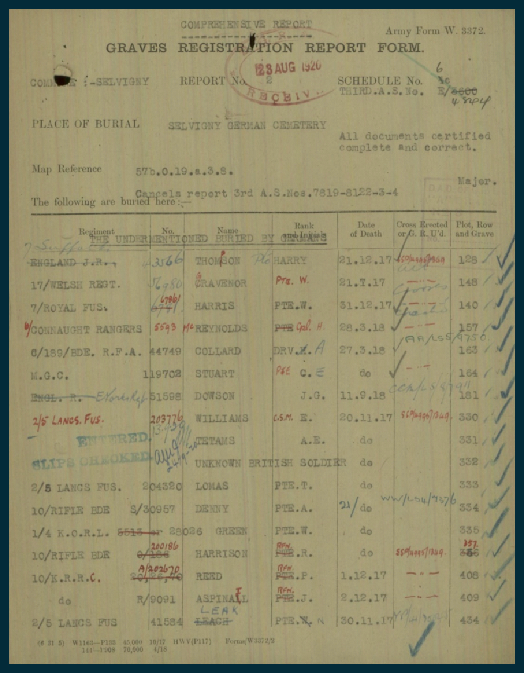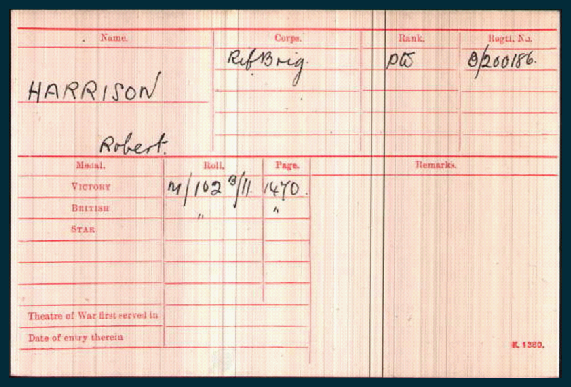Copyright © All rights reserved.



Robert Harrison
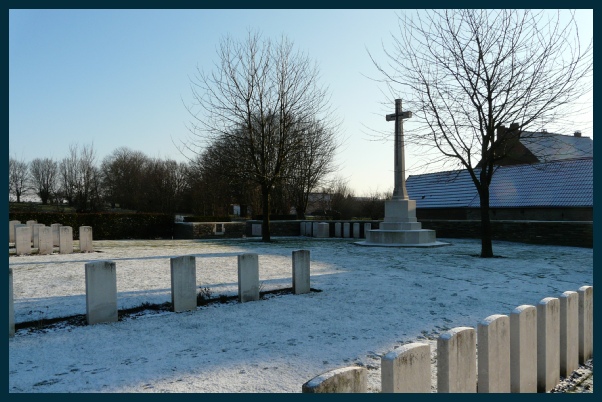
Robert Harrison was the third son of Thomas William and Lydia (nee Bunn) Harrison who married in New Malton on 27th March 1887 He was born in the second quarter of 1891 after the census in April, in the Malton area
Thomas and Lydia lived at 59 Market Place, (where Linton Pet shop is now) and according to the local community website, in addition to the painting business which Thomas ran, kept a Temperance hotel from 1893 to 1901. They had ten children two of whom died young.
1901 Census – resident at 59 Market Place, Malton
HARRISON, Thomas William, Head, Married, M, 38, Painter, York Yorkshire,
HARRISON, Lydia, Wife, Married, F, 39, , Bulmer Essex,
HARRISON, James William, Son, Single, M, 12, , Malton Yorkshire,
HARRISON, Edgar Thomas, Son, Single, M, 11, , Malton Yorkshire,
HARRISON, Robert, Son, Single, M, 9, , Malton Yorkshire,
HARRISON, George Wilson, Son, Single, M, 4, , Malton Yorkshire,
HARRISON, Rose Annie, Daughter, Single, F, 6, , Malton Yorkshire,
HARRISON, Evelyn Helen, Daughter, Single, F, 2, , Malton Yorkshire,
SIMPSON, Arthur, Boarder, Married, M, 32, Lang Agents Clerk, Halifax Yorkshire,
SIMPSON, Mary, Boarder, Married, F, 28, , Halifax Yorkshire,
SIMPSON, Phyllis, Boarder, Single, F, 1, , Leeds Yorkshire,
HARGRAVES, Frederick, Boarder, Single, M, 24, Shoemaker, Putsey Yorkshire,
REACHER, Mary, Boarder, Widow, F, 28, Sick Nurse, Leeds Yorkshire,
The family were active members of St Michael’s church – Robert and his brothers are recorded on the War Memorial as choristers. All three brothers were also members of Malton White Star Band –possibly three of the boys in the front row of this photo taken about 1907
At the end of March they were moved by train to Poperinghe. After a week of training they returned to Chateau Trois Tours and the same pattern of working parties and trenches resumed. They returned to Poperinghe at the start of May for more training before moving by train to Calais on 6th where they spent a week drilling and practicing on the beach before marching back to Poperinghe over the next week. After a couple of days of training at Poperinghe they were then sent on to Ypres, relieving 7th KOYLI and forming part of the reserve for 61st Brigade. While coming under spasmodic shelling they provided labour for working parties improving the front line defences.
At the beginning of June they moved up to the front line between Wietje and St Jean and remained in the forward area until mid-
On 3rd September the Battalion took part in the projected attack on Guillemont. This was successful but they suffered heavy casualties with 195 wounded and 95 dead or missing. After a few days of rest, cleaning up and training they moved forward again to trenches north-
After a few days rest and training they moved to trenches at Arrow Head Copse. These were old trenches and the first few days were spent in burying the numerous corpses that filled them, and salvaging abandoned stores. They were relieved by the French and moved into dugouts near Carnoy. While here they received a large draft to replace the recent losses and these men in particular found the vile conditions hard to cope with – the march forward to the trenches at the beginning of October over tracks knee deep in mud proved particularly gruelling. After an unpleasant week in the trenches with pouring rain and shortage of food they marched to Mericourt L’Abee where they trained and rested for a week. They spent the rest of October and most of November training at various camps until moving forward for a tour of road building in the forward area at the end of November which lasted until 9th December.
On 10th December the Battalion arrived in trenches south of Lesboefs. The relief of the trenches was carried out smoothly and without casualties but the tour was one of the most trying they had ever experienced. The trenches were incredibly basic and constantly falling in, and full of mud and water. It rained almost continuously turning to heavy snow on the 11th. Casualties were few but numbers of sick were very high. On the 11th a fire caused by petrol spillage nearly caused the destruction of the battalion HQ bunker but it was eventually smothered. As a result of the conditions the Battalion was withdrawn early. Among the few casualties was Robert, reported as wounded in action (duty).
They were relieved on the 13th and moved to “a camp of huts near Carnoy. The men were in a condition of extreme exhaustion, and most of them were carried on conveyances of all kinds picked up on the roads. The time spent in this camp was devoted to resting and cleaning.” They alternated between trenches and camp until Christmas, when they moved into billets in Corbie where training was resumed.
On 7th January they moved into trenches south of Sailly Saillisel. “The trenches, as compared with the last line held, were very much better, but they consisted chiefly of isolated posts. However, nearly every man had a shelter of some sort, and the number of sick was very small. On account of the closeness of the lines there was very little shelling.” For most of January they alternated between these trenches and similar ones near Combles – a largely uneventful tour of duty. Some excitement was provided when an enemy aircraft came down – the pilot was captured and unavailing attempts were made to salvage the plane.
After an intensely cold week in unheated billets, the battalion moved to trenches near Guillemont where they remained on and off for the rest of February and early March.
On the 16th March it was realised that the Germans were withdrawing and over the rest of March the front line steadily advanced to Etricourt, recapturing ground that had been lost and driving the enemy back to Metz. April was spent in preparing for and participating in a largely unsuccessful attack on Metz. On 25th April they moved into the Divisional Reserve at Bertincourt where further training took place. May was uneventful alternating shout tours in trenches with training in camp.
Training continued for the first week of June. “The whole of this rest was conspicuous for the most delightful weather. Sports, possibly the most enjoyable the battalion has had for a long period, were carried on every evening and sometimes in the afternoon as well. The final of the inter-
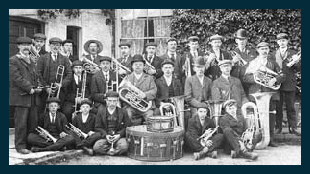
By 1911 Robert had moved out from Malton and was working as an “odd man” at Aldby Park in Buttercrambe.
1911 Census – resident at Aldby Park Buttercrambe York,
William Fellowes, Collins, Head, Married, Male, Major Royal Scots Grey, 45, Huntingdonshire Ramsey
Evelyn Annie, Collins, Wife, Married, Male, -
Fredrick, Bailey, Servant, Single, Male, Valet Domestic, 33, Wilts Malmesbury
George, Carr, Servant, Single, Male, Footman Domestic, 23, Yorks Old Malton
Robert, Harrison, Servant, Single, Male, Odd Man Domestic, 20, Yorks Old Malton
Emma, Hill, Servant, Single, Female, Cook Domestic, 31, Oxon Burford
Emmy, Muller, Servant, Single, Female, Ladys Maid Domestic, 29, Switzerland Resident
Helena, Skerry, Servant, Single, Female, Kitchenmaid, 27, Norfolk Docking
Ruthy, Handcastle, Servant, Single, Female, Between Maid Domestic, 26, Yorks York
Kate, Culverhouse, Servant, Single, Female, Housemaid Domestic, 36, Bucks Chesham
Hilda, Uphill, Servant, Single, Female, Housemaid Domestic, 19, Glos Amberley
Daisy, Bruce, Visitor, Married, Female, Nurse Domestic, 28, Middlesex Holborn
For some reason, Robert seems to have joined up in a territorial regiment in the London area, 3/8 London Regiment which was formed in early 1915 at Tadworth, Surrey. In October they moved to Blackheath and in January 1916 to Fovant near Salisbury. The Battalion changed its name to 8th Reserve Battalion in April 1916, and it was probably about then that Robert was transferred to 10th Battalion, Rifles Brigade and sent to the Western Front, quite possibly in the draft of 12 men who arrived on 13th March.
10th (Service) Battalion was part of the New Army and was another Southern unit having been formed at Winchester in September 1914. They had been in France since 21st July 1915. When the draft arrived the battalion were in the trenches and they remained at the transport lines until the battalion was relieved the following day. After a couple of days of night working parties they were all back in the trenches near Chateau Trois Tours. They were hard at work repairing and strengthening the defences and coming under spasmodic shelling from “whizz-
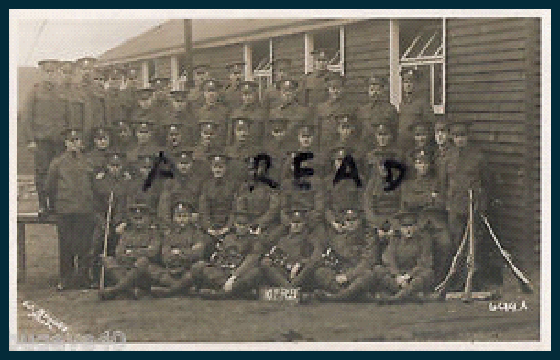
The first fortnight of August was spent preparing for a projected attack on the Steenbeck, part of the Battle of Langemarck, the second Allied general attack of the Third Battle of Ypres. The battle took place near Ypres and the main British gain of ground occurred near Langemark. The Allied attack succeeded in the north, from Langemarck to Drie Grachten (Three Canals) but early advances in the south on the Gheluvelt Plateau, were forced back by powerful German counter-
On the 14th August the Battalion made a preliminary attack, fording the Steenbeck and taking up positions mainly in shell-
The beginning of October saw them on the move again, this time to Heudicourt where they found themselves in well-
On 12th November “preparations were made for a big attack with tanks on the Hindenburg Line. For the first time a serious attempt at secrecy was being made, and this was fortunately favoured by misty weather.”
The attack took place on 20th November. “During the night of 20/21st the battalion advanced and took up a line and took up a line by the cemetery in M.4.b. At 6.20am on the morning of the 21st with a view to obtaining the bridgehead in Rue De Vignes the battalion attacked that village and occupied it successfully, in spite of considerable opposition, at about 8am. Neither side actually occupied the bridge but it was covered both by our own and enemy machine gun fire. About an hour after the capture of the village, the Germans who were still at the north end in considerable numbers worked around the rear of the battalion and forced three companies to fight their way back to their positions near the cemetery. One company maintained its position covering the bridgehead with Lewis gun fire.
In the evening a further advance was made in conjunction with one company of the 10th K.R.R.C. from the line of the cemetery. This company succeeded in entering the right of the village and gained touch with our own company there. Their joint forces in the village then mopped it up killing several Germans and capturing 11. Our forces then retired to a position in the open sloping ground in front of the village.” Casualties were heavy with 47 dead or missing and 90 wounded.
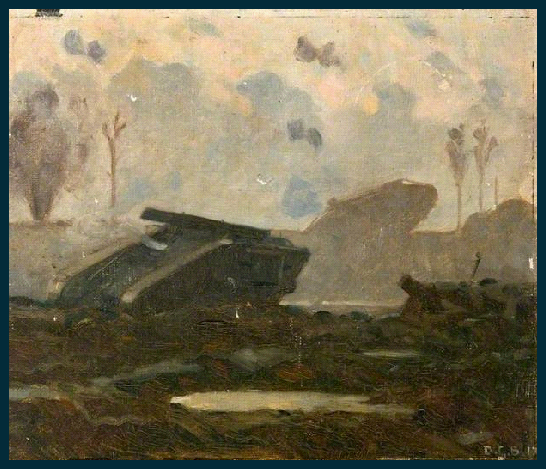
Among the dead was Robert Harrison. The exact time and day of his death appears to be unknown – dates given range from 20th to 22nd November 1917.
Robert’s body was buried by the Germans in Selvigny German Cemetery which is now a large permanent burial ground between the villages of Selvigny and Walincourt. It contained the graves of 106 soldiers from the United Kingdom, eight of whom were buried by their comrades in October 1918. After the war it was decided to consolidate the cemeteries and Selvigny became a German cemetery with German dead re-
Honnechy was part of the battlefield of Le Cateau in August 1914, and from that time it remained in German hands until the 9th October 1918, when the 25th Division and the 6th Cavalry Brigade captured it. It had been a German Hospital centre, and from its capture until the end of October it was a British Field Ambulance centre. The village was inhabited by civilians during the whole of the War. The cemetery stands on the site of a German Cemetery begun in the Battle of Cambrai 1917 and used by German troops and then by British until the 24th October 1918. The 300 German graves were removed to another burial ground, leaving 44 British graves; and the cemetery was re-
There are now over 450, 1914-
